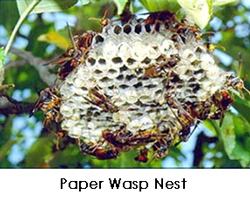Common Paper (nest) Wasp
Polistes humilis
Family: Vespidae
Order: Hymenoptera
Identification:
Rather slender wasp, 10-15mm long, tan in colour with darker bands and some yellow on face. Wings long and thin. Nest made of a grey papery wood fibre material, initially cone-shaped, later round, to a maximum diameter of 10-12cm, with numerous hexagonal cells underneath, some with white caps. Nest exposed, suspended by short stalk under an overhang, e.g. eaves or roof of a pergola, or sometimes in a shrub or tree. Wasps cluster on nest or forage in garden and around buildings. Other species of Paper wasps are larger or smaller and differently coloured.
Distribution:
Mainland south-eastern Australia, southern Queensland, New South Wales, the ACT, Victoria and South Australia. Polistes humilis are a native wasp species, but some other paper wasp species are introduced.
Life History:
A social wasp. Small colonies of 12-20 adults make "paper" nests by mixing saliva and wood fibres. Nest is a nursery where larvae (1 to each cell) are fed on chewed-up caterpillars before pupating, when cell is capped. Adults themselves feed on nectar. Most wasps die in autumn or winter, some hibernate to start new nests next season.
Pest Status:
Some beneficial value as predator of pest caterpillars. However, wasps have a painful sting and will attack any person approaching or disturbing nest. Nests likely to be disturbed represent a hazard.
Warning:
Do not go near nest during the day .
First Aid:
Apply a cold pack. Seek medical attention if symptoms become general or more severe.


